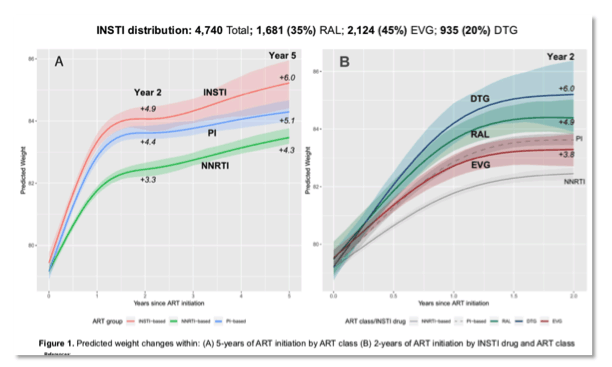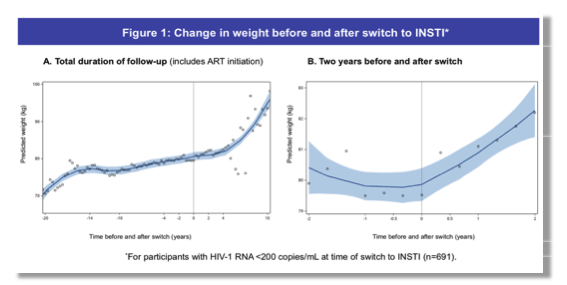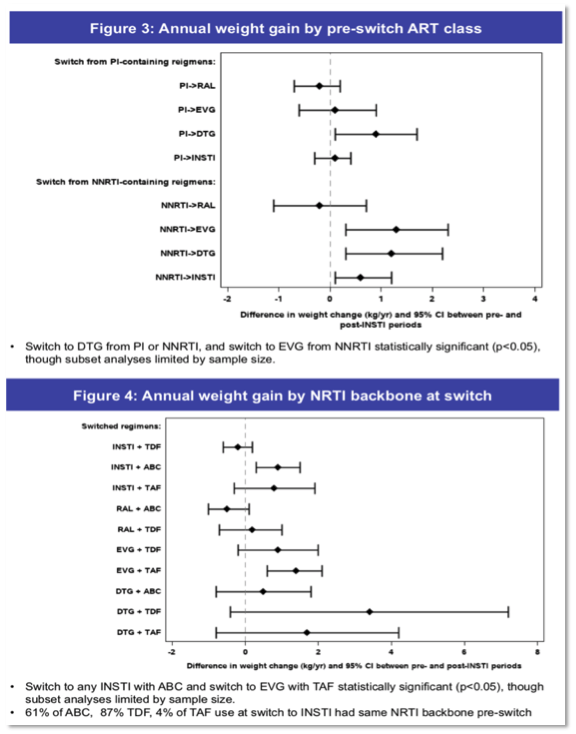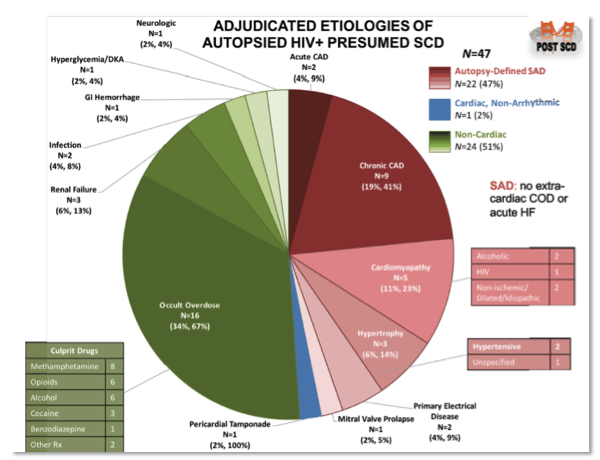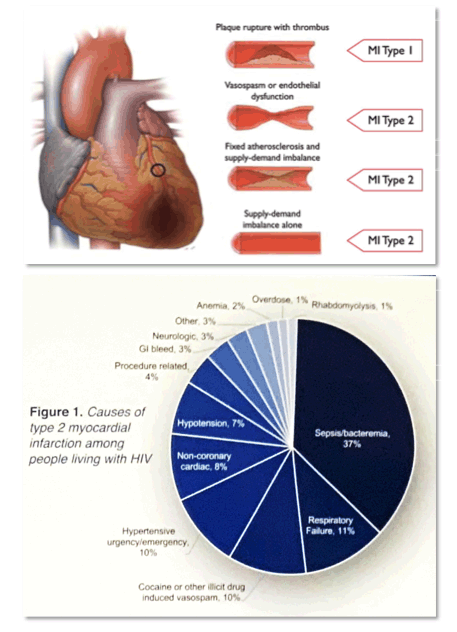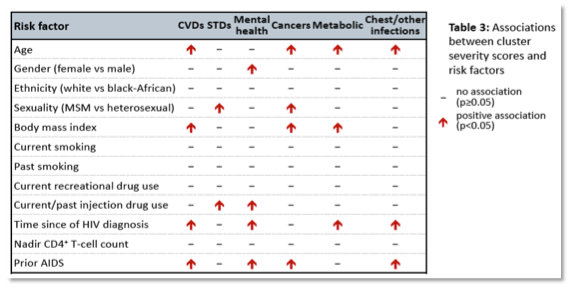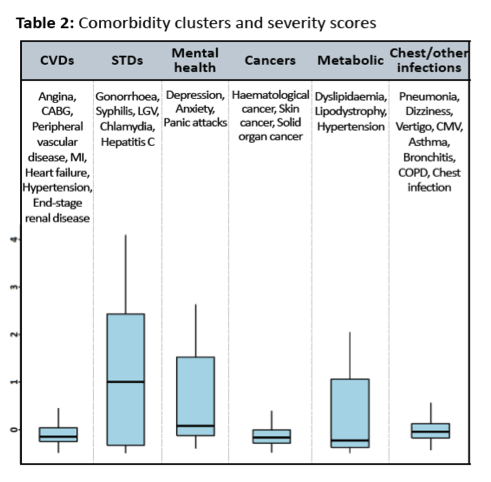Complicated Complications at CROI
Complicated Complications at CROIDavid Alain Wohl, MD – The University of North Carolina Institute of Global Health and Infectious Diseases Introduction What is Up with Weight Gain on ART? Increases in weight following the initiation of ART is common – particularly for those with lower CD4 cell counts. In the past, a jump in pounds was considered a consequence of a return to health with viral suppression and was a welcome sign of adherence (there are fewer data that describe the effect of HIV therapies on weight in those starting treatment with high CD4 cell counts, such as those with acute or recent infection). However, as more people living with HIV infection struggle with too much, rather than too little, fat, there has been concern over the past year or so about a trickle of reports from clinical cohorts suggesting ART regimens can impact weight differentially, with integrase inhibitors (INSTI) causing greater gains than other antiretroviral classes. The first of these studies looked at switches to INSTI from older combinations, such as those containing the non-nucleoside (NNRTI) efavirenz, in those with suppressed viremia, finding that weight went up with the change while remaining stable in patients changing to protease inhibitor (PI)-containing regimens or those who did not switch their ART.1 Within the INSTI a pecking order emerged with dolutegravir being associated with greater and elvitegavir with relatively less gains in weight; raltegravir was typically in between. At CROI, three major studies on weight gain and INSTI were showcased at a dedicated session. Each examined the issue in different populations of very varied sizes, applying disparate methods, and – unsurprisingly – emerge with somewhat dissimilar results: • NA-ACCORD2 – This analysis examined changes in weight with the initiation of ART in a large sample (N=24,001) of North American HIV-infected persons, applying a multivariate model that adjusted for age, race, sex, baseline weight, CD4 cell count, viral load, year of initiation, and clinical site. After two years, more weight was gained by those starting on an INSTI (4.9 kg) compared to a PI (4.4 kg) or an NNRTI (3.3 kg). Within the INSTI, dolutegravir produced most weight gain (6 kg), followed by raltegravir (4.9 kg) and then elvitegravir (3.8 kg). Weight continued to climb in all groups over 5 years with the differences between ART classes persisting. Sex and race were not observed to influence weight gains on INSTIs. The analyses did not look at the effect of companion drugs (such as nucleosides [NRTIs], or non-HIV concomitant medications) on weight gain.
GREATER WEIGHT GAIN AMONG TREATMENT-NAIVE PERSONS STARTING INTEGRASE INHIBITORS – (03/11/19) • ACTG3 – Trends in the weight of HIV-positive people (N=691) with suppressed viremia who are followed within longitudinal ACTG cohort studies were examined following the switch from a non-INSTI to an INSTI-containing regimen. Nicely, the presentation displayed weight changes both for the two years pre-and the two years post-switch to an INSTI.
As expected, weight went up with ART initiation (median nadir CD4 = 189/mm3) by about 0.4 kg per year and seemed to continue to slowly trend upward over time. However, after the switch to INSTI, weight shot up, increasing by 1.3 kg per year in analyses adjusted for sex, age, race, and BMI at the time of the switch. Again, among the INSTI, dolutegravir stood out with 1.3 kg per year gained versus 0.9 kg per year for elvitegravir and 0.3 kg per year for raltegravir. Interestingly, pre- and post-switch ART composition seemed to influence weight changes. Switching from a PI to INSTI was not associated with an increase in the rate of weight change except when the INSTI was dolutegravir (see figures 3 and 4). For switches from an NNRTI, all INSTI led to an increase in annual weight gain except for raltegravir. Among the NRTI companions, significant increases in weight gains after the switch were observed when abacavir accompanied an INSTI, unless the INSTI was raltegravir, Similarly, TAF plus elvitegrevir produced an uptick in the rate of weight gain, while TDF and elvitegravir did not. Too few people were receiving TAF plus dolutegravir to thoroughly examine this combination. Lastly, being a woman, of black race, or over 60 years of age was associated with greater risk of increased weight gain following the switch to an INSTI.
RISK FACTORS FOR EXCESS WEIGHT GAIN FOLLOWING SWITCH TO INTEGRASE INHIBITOR-BASED ART – (03/11/19) • TRIO Cohort4 – Weight changes on ART were also scrutinized in this cohort of patients attending one of six US clinics. In this analysis, changes in weight of 3% or greater were sought among patients with viral suppression switching to a new regimen. Notably, 6,721 patients had documentation of such a switch but only 3,468 (52%) had a BMI measured and documented at the start and one to two years later and were able to be included in the analysis. Of those with the weight data available, 30% had an increase of 3% or more in weight (16% had a drop of >3%). In their multivariable analysis, weight gain of >3% was associated with a lower baseline (I think this means at time of switch) BMI; while having hypogonadism, a psychiatric disorder (not well-defined), or having switched to a PI-based regimen was protective against this magnitude of weight increase. Non-PI use was linked to significant weight gain but not INSTI use specifically, suggesting that NNRTIs and INSTI produce similar weight increases when adjusted for included covariates – a finding that contrasts with most all other studies. The analysis is limited by the lack of BMI data on half the otherwise eligible patients and the choice of a threshold for weight increase. Unsurprisingly, fewer overweight and obese people has a 3% or more gain in weight because for them this is many more pounds to put on than for people who are at lower BMIs. For example, a 3% increase for a 130-pound person is 3.9 pounds but, for a 180-pound patient is 5.4 pounds. Significant weight increases among those with a higher weight at the start of initiation of ART, can be missed using this 3% threshold. The association between weight and psychiatric disorders is interesting, especially given many antidepressants and anti-psychotics can cause people to put on pounds. Unfortunately, data on non-HIV-related medication use was not included in this presentation/poster. CROI: Weight Gain During Treatment Among 3,468 Treatment-Experienced Adults with HIV – (03/11/19) Also presented was a “not me” analysis of weight changes with the injectable INSTI, cabotegravir.5 During a safety study of HIV-negative people (N=199), there was ~1 kg increase in median weight over 41 weeks of treatment with both active drug and placebo, with no significant difference between the groups. In addition, the first question asked of Brad Hare, who presented the results of the DISCOVER trial of PrEP with TDF/FTC versus TAF/FTC was differential weight gain. Prepared, he responded that there were greater gains in weight on TAF than TDF of ~1 kg, which with such a large sample size is likely to statistically significant. CABOTEGRAVIR IS NOT ASSOCIATED WITH WEIGHT GAIN IN HIV-NEGATIVE INDIVIDUALS – (03/06/19) The Bottom Line: Weight is complicated. It can be influenced by mood, appetite, activity levels, and food security, among other forces. With starts and switches in HIV treatment, assessing weight gets even more complex as some medications can produce low-level nausea or have food requirements that can also impact caloric intake. ART switch studies have to deal, particularly, with the potential that changes in weight might have more to do with the pre-switch regimen than the agents in the new combination. For example, coming off of efavirenz, with its recommended dosing on an empty stomach and co-formulation with TDF may in and of itself produce a change in weight. Similarly, one could see how a switch from a boosted-PI could lead to less gastrointestinal side effects and better appetite. For this reason, studies of initial ART may be a better gauge of the intrinsic ability of different regimens and their components to cause weight gain. Data from uninfected individuals, such as in early phase studies and PrEP, can also be informative. Too few trials present or publish weight data and the measurement of weight and BMI is typically not standardized or rigorous. Regardless of the confounding, people treated with INSTI, especially dolutegravir (we don’t know much about bictegravir yet, but it looks like may be similar to dolutegravir) have more weight gain – just like people with HIV infection have more heart attacks and lung cancer than HIV-negative people (and are more likely to use cocaine and be smokers). But the INSTI class is very useful and its alternatives are not all that pretty. As clinicians we should be aware of the potential for exaggerated weight gain and monitor weight or BMI. The association between high BMI and cardiovascular disease, cognitive impairment, and frailty, underscores the importance of taking weight seriously. If gains become unacceptable to the patient or the provider, a trial on an alternative regimen makes sense, along with the nutritional counseling most all of us can benefit from. Sudden “Cardiac” Death To die suddenly and unexpectedly is scary but, fortunately, uncommon. There has been concern, especially by a team of researchers in San Francisco, that people living with HIV are at higher risk for sudden death – defined by the WHO as witnessed unexpected death within 1 hour of the onset of symptoms or unwitnessed unexpected death within 24 hours of having been alive and free of symptom. But the extent that HIV is linked to sudden cardiac death has been murky. At CROI, a team from UCSF presented data from the HIV POST Sudden Cardiac Death Study, a rigorous, real-time examination of most all deaths in the city to detect and describe sudden cardiac deaths occurring in HIV-positive adults.6 Over the ~5 years since the study started, 1,379 people with HIV infection died and of these 769 were expected and thus not reported to the medical examiner. Of the other 610 people who died during this period, a review of paramedic field records suggested that 109 were cardiac arrest deaths; all but two of these went to autopsy. However, further review and family interviews found that 60 of these cases did not meet definition of sudden cardiac death (notably, almost half of these were witnessed overdoses). Thus, 47 deaths met the definition of sudden cardiac deaths during this 5-year period. Compared to over 500 sudden cardiac deaths that occurred in HIV-negative people in the city over the same timeframe, the 47 HIV-positive people with sudden cardiac death were younger and more often male and white. In addition, providing further evidence that HIV-infected people are different in many ways than the uninfected, the HIV-positive folks were more likely to have had a prior MI, have had a psychiatric diagnosis, have been a smoker, and have abused alcohol or illicit substances. At autopsy, almost half of the HIV-positive sudden cardiac deaths were adjudicated to be cardiac (CAD, cardiomyopathy, MVP, etc). The other half were determined to be non-cardiac with an incredible two thirds of these people found to have suffered an occult overdose. That is, 34% of all deaths thought to be sudden cardiac deaths were in actuality overdoses that the paramedics did not recognize and presumed to be cardiac. These are in addition to the few dozen known overdoses mentioned above. Methamphetamines, opioids, and alcohol poisoning were main substances detected on toxicology. The research team also looked at cardiac fibrosis, a marker of possible inflammation and a risk for arrhythmia and sudden cardiac death, in a subset of HIV-positive and HIV-negative sudden deaths. There was significantly greater fibrosis seen in the cardiac muscle of the HIV-positive than the HIV-negative cases. A separate study from the Veterans Aging Cohort (VACS) study group examined Veterans Administration (VA) data from 2003-2014 covering over 144,000 people (32% HIV-positive) followed in that system to identify sudden cardiac death.7 Of the 27,325 deaths in the cohort during this period, 3,338 met criteria for presumed (there was no autopsy confirmation) sudden cardiac death. Compared to the uninfected, HIV-positive cohort participants were about 15% more likely to suffer sudden cardiac death. However, an excessive risk for sudden death for HIV-positive people was only operative for those whose CD4 cell count was <200/mm3 and/or HIV RNA level was >500 copies/mL in models adjusting for a host of co-variates including demographics, co-morbid CVD risks, known cocaine and alcohol abuse, obesity, and ART. In addition, besides the expected risks of being male, age, smoking and prior CVD, other factors independently associated with sudden cardiac death in HIV-positive people included HCV co-infection, obesity, alcohol abuse, anemia, and COPD. One wonders how many of the deaths included in this study were occult overdoses, given the findings of the San Francisco autopsy data, described above. The Bottom Line: People infected with HIV are at higher risk for sudden death. However, both of these studies make clear that this is not simply a consequence of being infected with this retrovirus or some inflammatory storm stirred up by its latency in lymphocytes. Instead these studies portray the challenged lives many people living with HIV face – struggles that are almost literally etched into their hearts. At autopsy, over half of the so-called cardiac sudden deaths were discovered to be non-cardiac and in a lion’s share of these death was at the hands of crystal meth, heroin, or alcohol. Infarction and coronary artery disease were less likely to be found in the HIV-positive cases. This jives closely with stunning data derived from the US CNICS cohort that finds half of MIs among HIV-positive people is of the type 2 variety – due to vasospasm and supply-demand mismatch and not type 1 ischemia.8 Of these type 2 MIs, 1 out of 10 were due to substance abuse and almost 40% were a consequence of sepsis – triggers that are unlikely to be addressed by agents that reduce IL-6 or TNF.
Even the VA study, in correlating unsuccessful control of HIV infection and sudden death, is likely unearthing a downstream effect of substance use disorders on this most ultimate of outcomes. Other studies presented at CROI also included tables containing rows reporting the odds of something related to one sort of substance use of another. Under-appreciation of HIV risk, suboptimal persistence of PrEP, lack of response to ART, development of malignancies, acquisition of STIs, lower rates of retention in care, among others, were found to be influenced by the abuse of substances illicit and licit. While inflammation may well be an engine propelling some people to early adverse events and deserving of research, we should not accept the toll of substance abuse disorders as being anything approaching natural. All pillars of plans to eliminate HIV are on shaky ground if substance abuse and its mental health roots are not addressed. It’s Worse with HIV and What to do Hand-wringing about higher rates of adversity hounding people living with HIV infection is, by itself, of little value. Data are best when they can inform and guide decision-making, policy, and interventions. As mentioned above, revelations about the underlying facilitators of poor outcomes can assist with priority-setting and resource allocation. Below are some CROI presentations that identified problems for which there can be solutions. • Chronic Obstructive Pulmonary Disease (COPD) – A subset of participants in the Multicenter AIDS Cohort Study (MACS), which has longitudinally been following men who have sex with men (MSM) with and without HIV-infection for many years, underwent pulmonary function testing to assess the prevalence of and risk factors for COPD.9 Just over a thousand men (591 HIV-positive, 476 HIV-negative) were studied. The HIV-positive men were more likely to be current smokers (26% vs 20%) and to smoke marijuana (35% vs 25%) compared to those without HIV infection. In analyses adjusted for age, race, smoking, viral hepatitis, illicit drug use, when enrolled, and study site, HIV-positive men were found to have a statistically significant (but probably not so clinically significant) 2.6% lower diffusing capacity for carbon monoxide, also called DLco. This measures the ability of oxygen that gets breathed in to pass from the lungs to the blood. The HIV-positive men also had higher odds of a DLco level below 80% (39% vs 33%) and 60% (6% vs 3%) of predicted. Markers of lung mechanics, that is the ability to breathe unobstructed, including the forced expiratory volume (FEV) and forced vital capacity (FVC), as well as a COPD diagnosis were not different between HIV-positive and -negative participants. Lower current and nadir CD4 cell counts were associated with worse lung function. These findings suggest, reassuringly, that HIV itself does not cause impairment of lung function when other known risk factors are also considered. Somewhere in this review has to be the words: smoking cessation is the most important thing a provider can do for their HIV-positive patient, after suppressing viral replication. There they are. • Fractures– In keeping with the theme, people living with HIV infection suffer more bone fractures than people without, and their bone density is generally lower. Lots of factors go into the risk-mix but a study from the US HIV Outpatient Study (HOPS), dodging the question of origin, looked at the incidence and consequences of fractures in patients at the study clinics.10 From 2000 to 2017, there were 506 patients with a fracture among the 6,853 followed (so, ~7% had a fracture). Most of these fractures were not considered osteoporotic and some were traumatic. Those with a new fracture were younger, more likely to be white, be a smoker, report 14 or more alcoholic drinks per week, and have an AIDS diagnosis. This tells you a lot already. Experiencing a fracture was found in a multivariable analysis to be associated with a 45% increased risk of death (overall, 75 of the 506 with a fracture died). But, over time, the mortality risk associated with fracture and whatever it represents declined substantially. Further, additional analyses point to renal disease, HCV infection, cancer, and lung disease as being major drivers of the demise of those who had broken a bone. The moral is that a fracture, much like anemia, accompanies conditions or behaviors that are threats to living long and prospering. In addition to prompting testing for vitamin D, a fracture of any sort (save for those occurred during rollerblading or snowboarding) should heighten concern for underlying problems that may be obvious or not. CROI: BREAKING BONES IS BAD: INCIDENT FRACTURE AND MORTALITY IN THE HIV OUTPATIENT STUDY – 45% Increased Mortality Associated with Fracture – (03/06/19) • It’s a Complications Cluster- That complications in and to the lives of people dealing with HIV infection are often co-occurring is not news to patients or providers. But, to better describe their patterns researchers from a United Kingdom cohort study explored clusters of complications in almost 1,100 HIV-positive participants, two-thirds older than 50 years of age.11 This population was mostly white, male, and MSM; 90% had suppressed viremia. Comorbid conditions clustered as indicated in Table 2, which also shows calculated severity rating. Risk factors for experiencing a cluster is shown in Table 3. BMI and drug use were the most mutable of these factors in this analysis. Clearly, earlier HIV therapy and treating to target blood pressure and lipids, could also be expected to reduce the prevalence of clusters and their components.
• Suicide – Like overdose and premature deaths due to smoking and drinking, suicide is reducing life expectancy in the US – particularly in “Make America Great Again” country. In the NA-ACCORD suicide was examined from 2000-2015 among people living with HIV.12 Among 81,123 adults in the cohort, there were 217 known suicides. All but two of the suicides were men. There was a more than 4-fold greater rate among white men compared to black men and white injection drug users had the highest rate of all (9-fold higher than non-injecting Black men) – well above rates for white men in the general US population. What can better signal suffering than a decision to end one’s life? Suicide among people living with HIV takes many forms but is a common pathway of sadness fed often by stigma, isolation, poverty, and, yes, substance abuse – each addressable with potent policy, rather than potent ART. CROI: Suicide rates among adults living with HIV, 2000-2015 – (03/28/19) Summary Studying ways to mitigate chaos (substance abuse, stigma, lack of support, low health literacy, etc) is not as easy as testing a novel immune-activation blocker. People are complicated, as are interventions and too often what is tried fails. When a program is found to be successful it is usually too expensive or cumbersome or site-specific to be useful to anyone. Further, our efforts are typically directed at the end result of a lifelong process, such as heavy drinking or opioid addiction, and not its antecedents; therefore, we fight to put out the smoke and not the fire. In looking at people getting older with HIV we may be obsessing at the wrong end of the problem. Rather than focus on those with bad outcomes perhaps we would do better to look at those who are aging marvelously with HIV. If we are aiming for success, let’s look for the independent predictors of success. We just may be surprised to find it is not all good genes or the inverse of the factors that portend unhappiness and adversity that account for some thriving with and despite HIV. Data from CROI spell out what is wrong. Let’s understand what contributes to a phenotype of success that we can emulate and share to help keep things right. 1. Norwood J, et al. Brief Report: Weight Gain in Persons with HIV Switched from Efavirenz-Based to Integrase Strand Transfer Inhibitor-Based Regimens. Journal of acquired immune deficiency syndromes. 2017;76(5):527-31. |
||
